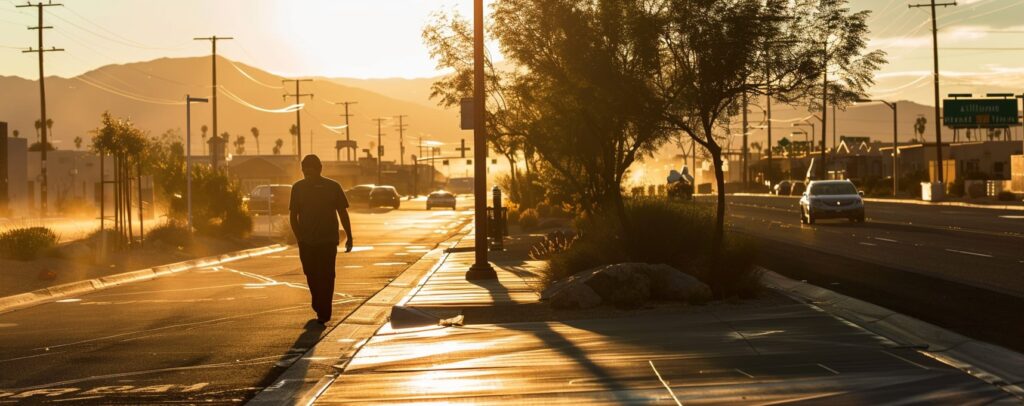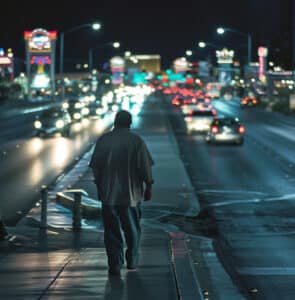
Most pedestrian collisions occur in urban and rural settings, each with distinct challenges. Understanding these high-risk zones is crucial for prevention. This article maps out the areas where pedestrian safety is compromised and discusses actionable countermeasures.
Key Takeaways
- Urban areas are hotspots for pedestrian collisions due to high population density, heavy traffic, and inadequate infrastructure, resulting in 81% of pedestrian fatalities in 2018, highlighting the need for improved urban planning and driver attentiveness.
- Despite occurring less frequently than in urban settings, pedestrian accidents in rural areas tend to have higher severity, with fatalities often occurring along two-lane roads and outside designated crosswalks, indicating a need for better infrastructure and law enforcement.
- Intersections pose significant risks for pedestrian safety due to the complexities of navigating multiple streams of information, necessitating enhancements such as clear signage and heightened driver vigilance to prevent collisions and improve safety.

Pedestrian Collisions in Urban Settings

The adversary of the urban pedestrian is often a distracted motorist. A glance at a cellphone, a momentary distraction, can shatter lives. Speeding, too, increases the risk of drivers striking pedestrians. What makes the urban setting more perilous, however, is the lack of pedestrian-friendly infrastructure. Many cities lack adequate sidewalks, designated crosswalks, and bike lanes, forcing pedestrians onto the road where they encounter motor vehicles in their path.
Given the complexity of the urban landscape, we must prioritize pedestrian safety in urban planning. Significant reductions in pedestrian accidents can be achieved in cities that promote walkability by designing roads to accommodate foot traffic and street crossings. Moreover, it is essential for drivers to adhere to traffic signals and maintain a sharp lookout for pedestrians, especially in areas beyond designated crosswalks or intersections.
Pedestrian Collisions in Rural Environments
Miles away from the urban jungle, rural environments present a different set of challenges for pedestrian safety. The tranquility of the countryside conceals the perils that lurk on rural roads – unpaved road shoulders and a lack of sidewalks on rural highways increase the risks for pedestrians.
Rural pedestrian accidents, although fewer in number, are often more severe, with high fatality rates exacerbated by higher vehicle speeds. The most common locales for these accidents are along two-lane roads and midblock locations, where most pedestrian accidents and 73% of fatal pedestrian accidents occur outside of designated crosswalks or intersections. It is in these areas where pedestrian accident fatalities occur at an alarming rate.
Rural environments emphasize the importance of pedestrian-friendly infrastructure and strict enforcement of traffic laws. Pedestrians must be particularly vigilant when walking along rural highways, especially when sidewalks or paths are not available. Simultaneously, drivers should adhere to speed limits and be alert for pedestrians on the road, including street mid block highways where pedestrian activity may be higher.
The Perils of Intersections
The complexity of intersections, where pedestrians cross paths, presents a significant challenge for pedestrian safety. These junctions demand drivers to process diverse and simultaneous streams of information, which can overwhelm drivers and lead to errors, resulting in accidents involving pedestrians.
Enhancement of intersection safety necessitates careful civil design and engineering. Features like clear signage, proper lighting, pedestrian crossings, bike lanes, and traffic calming measures can enhance pedestrian safety. However, notwithstanding these measures, the responsibility rests heavily on drivers. Vigilance is key, requiring drivers to slow down, prepare to stop, and yield to pedestrians, ensuring that crossing individuals are visible to all road users.
Even though the majority of pedestrian fatalities occur on non-intersection roadways, intersections continue to be a significant site for pedestrian-motorist collisions, often resulting in fatal injuries. This underlines the critical need for improvements and heightened awareness in these areas.
Parking Lot Hazards
From shopping malls to office buildings, parking lots are ubiquitous in our daily lives. Yet, their familiarity often leads us to overlook the significant hazards they present. A combination of factors like driver distraction, poor visibility, and unpredictable movements of vehicles and pedestrians contribute to the high risk posed by parking lots. These factors can contribute to potentially hazardous situations for both drivers and pedestrians..
To ensure safer parking experiences, drivers should consider parking further from buildings, avoiding reversing whenever feasible, and being cautious while reversing. Meanwhile, pedestrians are advised to utilize crosswalks and sidewalks when available and stay alert, as overconfidence in drivers’ ability to see them can be dangerous.
The seriousness of parking lot hazards is underscored by the fact that over a ten-year period, more than 2,000 individuals lost their lives in business parking lots. This alarming statistic underlines the urgent need for pedestrians and drivers alike to exercise caution in these areas.
Nighttime Pedestrian Collisions/Accident
Pedestrians can be dangerously concealed under the cover of darkness. Nighttime brings a host of challenges for pedestrian safety, with reduced visibility being a prime factor. Despite advancements in vehicle lighting technology, pedestrian visibility is greatly reduced at night, especially when dark clothing and lack of reflective gear come into play.
The risk of accidents is further heightened by poor weather conditions and drowsy driving. A driver without sleep for 18 hours is comparable to having a blood alcohol concentration of 0.08, significantly impacting pedestrian safety.
Considering these risks, pedestrians can employ strategies to enhance their visibility during nighttime. Wearing light colors and reflective clothing, and using flashlights or headlamps can make a significant difference.
Conversely, it’s up to drivers to maintain a consistent watch for pedestrians and not be a driver ignores traffic signals, to avoid accidents.
Contact us today and we will help you get the compensation that you deserve.
Identifying Negligent Drivers
Identifying the negligent driver is an essential step towards justice following a pedestrian accident. To hold a negligent driver accountable, victims must prove the driver’s failure to exercise due care. Actions such as speeding, running red lights, and distracted driving fall under this category.
Establishing negligence often requires gathering evidence such as:
- Police reports
- Eyewitness statements
- Traffic camera footage
- The driver’s cell phone records
However, the complexity of the process can be daunting for victims, particularly when grappling with the physical and emotional aftermath of serious injuries from the accident, some of which may even be severe injuries.
In such challenging times, the role of an attorney becomes pivotal. Victims can rely on an experienced pedestrian accident lawyer to:
- Guide them through the legal complexities
- Collect essential evidence
- Manage communications with insurance companies
- Present the case in court if required.
Compensation Rights for Pedestrian Accident Victims

Economic damages include compensation for medical bills, lost income, and rehabilitation expenses. These costs are designed to help the injured party recover financially from the accident or injury. The settlements vary from $10,000 to $500,000, depending on the severity of the injury and other factors. Non-economic damages are intended to compensate individuals for pain, suffering, emotional distress, and loss of enjoyment in life. These damages are not related to financial losses and are considered separately in legal proceedings..
The role of a pedestrian accident attorney is pivotal in securing fair compensation for victims. An attorney can:
- Negotiate with insurance companies
- Consider all aspects of both economic and non-economic damages
- Ensure the victim receives a fair and realistic compensation.
Legal Assistance in Pedestrian Accident Cases
Following a pedestrian accident, obtaining legal assistance is not merely beneficial; it’s crucial. An attorney can help severely injured individuals focus on recovery while they handle the legal obligations.
Insurance companies often aim for quick settlement offers. However, these may not reflect the true value of the claim. In such instances, a pedestrian accident lawyer can ensure a fair and realistic compensation through adept negotiations.
An attorney’s role in securing justice for the victim includes:
- Gathering crucial evidence
- Consulting on initial steps post-accident
- Representing the victim in insurance negotiations
- Pursuing lawsuits if necessary
Pedestrian Safety Tips
Although it’s important to understand the hazards of pedestrian accidents, taking proactive safety measures can significantly help in preventing them. Using crosswalks and intersections whenever possible reduces the risk of accidents since these are areas where pedestrians are expected by drivers.
Pedestrians need to be extra watchful for vehicles in parking lots and driveways, as these locations can present unexpected dangers, such as a person laying on street. Similarly, drivers can minimize road risks by remaining vigilant and adhering to the traffic rules.
The use of sidewalks is a highly effective preventive measure for pedestrians. When sidewalks are not present, walking facing traffic at a safe distance is advised. Safe and responsible road behavior is not just a legal obligation; it’s a moral duty that we owe to ourselves and others.
Frequently Asked Questions
What factors contribute to pedestrian accidents in urban areas?
Pedestrian accidents in urban areas are often caused by high population density, heavy traffic, distracted driving, and lack of pedestrian-friendly infrastructure. It is important to address these factors to improve pedestrian safety.
Why are intersections risky for pedestrians?
Intersections are risky for pedestrians because the complexity overwhelms drivers and can lead to errors, increasing the likelihood of accidents involving pedestrians.
Are pedestrian accidents more severe in rural environments?
Yes, pedestrian accidents in rural areas tend to be more severe due to factors such as unpaved road shoulders, the absence of sidewalks, and higher vehicle speeds. This is because these conditions can increase the likelihood of severe injuries for pedestrians.
How can legal assistance help pedestrian accident victims?
Legal assistance can help pedestrian accident victims by negotiating for fair compensation, gathering evidence, and providing representation in court if needed. It’s essential for navigating the legal process and ensuring a fair outcome.
What are some pedestrian safety tips to prevent accidents?
To prevent accidents, pedestrians should use crosswalks and intersections, remain vigilant in parking lots and driveways, and use sidewalks or walk facing traffic at a safe distance when sidewalks are not present. Be cautious and follow traffic rules to ensure safety.
Last updated Thursday, June 20th, 2024 | Written by Puneet Garg





